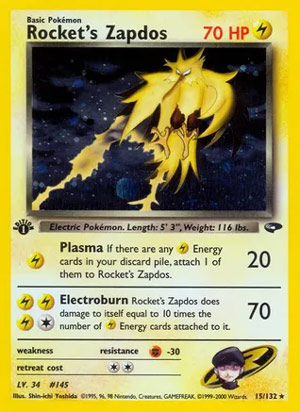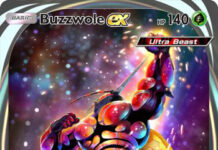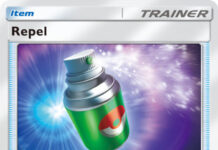
Rocket’s Zapdos – Gym Challenge
Date Reviewed: December 16, 2021
Ratings Summary:
Standard: N/A
Expanded: N/A
Ratings are based on a 1 to 5 scale. 1 is horrible. 3 is average. 5 is great.
Reviews Below:

Otaku
Rocket’s Zapdos (Gym Challenge 15/132) was once the heart of the top deck in the metagame. The card officially released on October 16, 2000. It was the topic of one of Ness’s original Card of the Day articles for Pojo.com. We re-reviewed it on July 27, 2017 as a Throwback Thursday pick, just like it is today. So, why are we reviewing it yet again? Because it got a reprint in Celebrations, as one of those card with the original Set ID/Card# but with a 25th Anniversary Stamp. This card is also a good way to address the end of something that is well known about the early days of the Pokémon TCG: the Haymaker deck. Which is a notion I cannot take credit for; you’re basically getting a blend of my own take on the card and what Jason ” Ness” Klaczynski has to say about Rocket’s Zapdos on his own site.
Rocket’s Zapdos is a Pokémon with an “owner” in its name. A few generic support effects from back in the day wouldn’t work for such cards. “Rocket’s” meant it shared support with only fellow “Rocket’s Pokémon”, and eventually with Pokémon that have “Dark” in their name. The latter was the original mechanic used to represent a villain organization corrupting Pokémon; for some reason they didn’t want Dark-in-name Basic Pokémon, so they also invented Rocket’s Pokémon… plus Team Rocket’s Pokémon, in the case of Team Rocket’s Meowth. This was also before the creation of Darkness type Pokémon, which would further confuse things for a while. Rocket’s Zapdos counts as an entirely separate entity from baseline Zapdos cards, Zapdos-ex, and even Rocket’s Zapdos-ex. The support I mentioned didn’t materialize until this mechanic was revisited early in the EX-series (the sets based on Gen III) from a few years after Rocket’s Zapdos was a key player any competitive decks, but you know me and covering details like this.
Rocket’s Zapdos is a [L] type, and this proved useful due to the amount of [L] Weak Colorless and Water type Pokémon. While Haymaker decks at this point no longer had to rely heavily on type-matching, it was still a useful bonus. Rocket’s Zapdos was a Basic, so you could open with it, easily drop it into play on your turn, bounce it with Scoop Up, etc. Even at this point in the game, were some decks that could punish a player for relying on Basic attackers, and there were some Evolutions among the top decks… but being a Basic was still best. Rocket’s Zapdos has 70 HP, the “magic number” at the time for a Basic because competitive decks usually needed time to hit that number… or at least three or four copies of PlusPower. Making it even more sturdy, Rocket’s Zapdos has a perfect lack of Weakness, and a then-valuable Resistance (Fighting). While Fighting types weren’t on top at this time, Lightning types other than Zapdos-cards were usually Fighting Weak. The Retreat Cost of [CC] wasn’t high enough to be bad, but it wasn’t low enough to be good.
Rocket’s Zapdos knows two attacks and this time… both attacks are good and combo with each other like you’d expect. “Plasma” does 20 Energy for [L], back when this was a very competitive amount. Most evolving Basics had 40 or 50 HP at this time, and even competitive Basics and Stage 1 Pokémon had more like 60 to 90. Well, 20 base damage plus Weakness and/or PlusPowers had a lot of mileage but there’s more! Plasma has an effect: if there are any [L] Energy cards in your discard pile, you attach one of them to this Rocket’s Zapdos! This was good for reducing the impact of an opponent using Energy Removal or Super Energy Removal, of fueling your own Super Energy Removal or helping with Retreat Costs, and of course, paying for the card’s second attack, “Electroburn”. Priced at [LLLC], this attack would have been painfully out of reach without Plasma, but thanks to that first attack, you could open with Plasma and – barring an opponent’s interference – jump to Electroburn. An attack that hit that key 70 damage. Electroburn does have a drawback, and it did matter back then: the attack also caused Rocket’s Zapdos to hurt itself. Specifically, 10 damage per [L] Energy attached to it at the time of attacking.
Rocket’s Zapdos might have been a bad card if the right support wasn’t available… but it was. First, you had the fantastic draw and search of this era: Computer Search, Erika, Professor Oak, etc. Then you had the disruption provided by cards such as Energy Removal, Super Energy Removal, and the Trapper Combo (Imposter Oak’s Revenge => Rocket’s Sneak Attack => The Rocket’s Trap). The final evolution of the vintage Haymaker deck backed Rocket’s Zapdos up with Erika’s Jigglypuff, even better at OHKO’s thanks to its “Pulled Punch” attack. Since it has been so different for so long, let me remind you that this was an era when the only “First Turn Rule” was no evolving. You could use any Trainers you wanted, attach an Energy, and attack even on Turn 1. Pulled Punch did 40 damage for [CC], and both Double Colorless Energy and PlusPower were legal. If you’re wondering how Rocket’s Zapdos could be good when it was doing at least 30 damage to itself, “Defender” was also a thing. A “normal” Trainer (what we’d now call an Item) that you attached to a Pokémon but which did not count as a Tool. Tools didn’t exist until the next set after Gym Challenge! Defender reduced the damage a Pokémon took from attacks (even its own) by 20, and multiples could stack.
I’ve said it before, but listing official, sanctioned tournament formats from this time can be tedious. Wizards of the Coast, the company originally in charge of the Pokémon TCG, coined the term “Standard” Format to refer to the default format for Organized Play. Unfortunately, as this original Format was Base Set-On, many players (myself included) thought that is what “Standard” meant. Instead, we went with the alternate title of “Modified Format”, something else that WotC would sometimes use to describe the current Standard Format. Just to make things more confusing, there was also the Prop 15/3 Format, only used for a single official event. Base Set-On, but no more than 15 Trainers in a deck and the 4 Copy Rule was now the 3 Copy Rule. Rocket’s Zapdos decks was a strong presence when it was new, and even in Prop 15/3.
In the original “Modified” Format, though, Rocket’s Zapdos lacked a lot of the support it needed. Plus, it had to compete with broken cards like Sneasel (Neo Genesis 25/111) and Slowking (Neo Genesis 14/111). Literally broken in the case of Slowking, as it had a mistranslation that turned it from a “meh” card into something most competitive decks had to run. In the Unlimited Format of this time… Slowking and Sneasel were still legal. There were still some creative uses of Rocket’s Zapdos that led to viable decks. The original iteration of Metal Energy was actually a Special Energy card. Just to make it more confusing, this Special Energy card had an effect that would later be changed, so you need to look at Metal Energy (Neo Genesis 19/111; Expedition 159/165Aquapolis 143/147). Later versions had the Energy card provide [M] while attached to a Pokémon, and if that Pokémon was a Metal type, it took 10 less damage from attacks (made by either player’s Pokémon), after applying Weakness and Resistance. The original did all of these things except the damage reduction worked for Pokémon of any type. Non-Metal type Pokémon would just do 10 less damage, however. Rocket’s Zapdos exploited that original effect. Yes, it meant Electroburn would do 60 damage (instead of 70) to your opponent’s Active, but it also meant that Rocket’s Zapdos would do -20 damage to itself (takes 10 less damage, does 10 less damage, and both would apply to self damage).
It should be pretty clear that, in the modern metagame, Rocket’s Zapdos couldn’t cut it. Power creep has long left behind its HP and damage output. No Turn 1 attacks means even an updated version of Plasma wouldn’t be as good. Still, Rocket’s Zapdos can make for a bittersweet trip down memory lane, or a brief flash of what the game was like during one of its worse times.
Ratings
- Standard: N/A
- Expanded: N/A
We would love more volunteers to help us with our Card of the Day reviews. If you want to share your ideas on cards with other fans, feel free to drop us an email. We’d be happy to link back to your blog / YouTube Channel / etc. 😉
Click here to read our Pokémon Card of the Day Archive. We have reviewed more than 4700 Pokemon cards over the last 21+ years!



